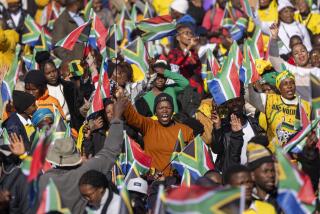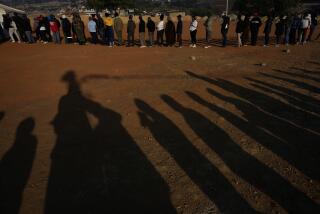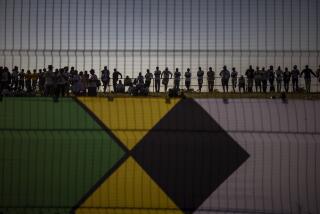SWAPO’s Guerrillas Are Exchanging Their Fatigues for Suits and Bullets for Ballots
WINDHOEK, Namibia — Theo-Ben Gurirab, a young teacher with dreams of black liberation, stuffed some carefully falsified identity papers into his pocket 27 years ago and stole onto an outbound train just ahead of the South African authorities.
Once outside Namibia’s borders, he earned a master’s degree at an American university, married an American fashion merchandiser--and helped guide one of Africa’s bloodiest guerrilla wars.
Now, “Comrade Ben” and most of his fellow, middle-aged guerrilla leaders have returned in their silk ties and Italian loafers to the territory where they would have been hanged for treason only a year earlier.
“We’ve come back to wage an election campaign,” Gurirab said the other day in the new $1.1-million headquarters of SWAPO, the South-West Africa People’s Organization. Later, he took a chauffeur-driven car from SWAPO’s motor pool to catch a plane for consultations in Zambia.
From Bullets to Ballots
After a war that cost 20,000 lives and a diplomatic struggle that stretched over a decade, SWAPO’s guerrillas have laid down their arms and returned to this vast, dry and sparsely populated territory to fight their final battle at the ballot box.
SWAPO is heavily favored to win the U.N.-monitored elections, which will formally end 74 years of South African control here. And Theo-Ben Gurirab, 49, the rebels’ bearded international affairs chief and for 15 years SWAPO’s U.N. representative, is likely to become foreign minister of the world’s newest independent nation.
On his first weekend home, Gurirab drove to Usakos, his birthplace, and was introduced for the first time to a passel of nieces, nephews and cousins--and heard how his uncles and aunts were harassed by the authorities for months after his disappearance in 1962.
“Going back to my roots, walking around the places I had not seen in so long, . . . that’s when I realized I was truly back home,” Gurirab said.
Banners and Slogans
The Namibia he has returned to is draped in colorful banners, its airwaves and newspapers clogged with sloganizing and mudslinging, and everyone from black guerrillas to white farmers has taken to the hustings for a first taste of free elections.
Namibia’s march to nationhood was almost halted by an outbreak of fighting in April, but now it again is moving toward November elections under the gaze of 5,000 U.N. troops, 1,500 U.N. police officers and dozens of international monitoring commissions. Namibia’s independence is a key component of the U.S.-brokered peace accord, which has begun a Cuban troop pullout from Angola and opened the way to peace in southern Africa.
But the territory remains tense, with allegations of voter intimidation by both former guerrillas and the South Africa-led police force. In recent weeks, a grenade attack on a U.N. base left a private security guard dead, a 10-year-old SWAPO supporter was struck in the forehead and critically injured by an arrow, and a campaign worker for the Democratic Turnhalle Alliance, SWAPO’s main rival party, was gunned down in his home.
To Write New Constitution
In five days of voting beginning Nov. 6, about 700,000 people will select a constituent assembly, which will then need a two-thirds majority to write a new constitution. The U.N. special representative here will be called upon to verify that the South Africa-administered elections are “free and fair.” The organization that once ambushed South African military patrols and planted bombs in butcher shops and hotels has become, virtually overnight, the picture of mainstream party politics.
SWAPO’s modern five-story headquarters in Windhoek’s quiet downtown is crammed with computers, copiers, fax machines and office workers. At least one photograph of SWAPO President Sam Nujoma, and sometimes two or three, hangs on every office wall. Behind the desks are men wearing Nujoma-style beards.
“It’s a madhouse, really,” Hidipo Hamutenya, SWAPO’s information secretary, told one of a dozen callers who interrupted an interview in his office one afternoon.
Hamutenya and Gurirab are two of SWAPO’s top seven leaders, and they met that day with a half-dozen officials, including a U.S. Senate staff delegation. Nujoma himself has yet to return to Namibia; SWAPO leaders say they are waiting for an appropriate time to bring back “our big gun,” as one put it.
SWAPO has 10,000 campaign workers, all volunteers working for food and housing, in 16 offices. They are trying to get as many voters registered as possible before the Sept. 15 deadline, selling SWAPO posters and buttons, typing letters, ferrying officials in some of the organization’s 300 cars, and lodging frequent complaints with the U.N. and the South African administration about alleged pre-election irregularities.
SWAPO complains that South Africa’s registrars have been lax in their registration efforts in the rural north, the birthplace of SWAPO, where 60% of Namibia’s 1.3 million population lives. So far, 250,000 voters have registered in the northern province of Ovambo, and SWAPO says thousands have been overlooked.
16-Hour Journeyu to Polls
SWAPO also thinks South Africa is trying to rig the election by encouraging South Africans to travel to Namibia to vote. So far, more than 3,000 white South Africans have registered, some making 16-hour journeys in chartered buses. Under the registration rules, anyone who lived in Namibia for four years or had a parent born in Namibia is eligible.
But in recent weeks SWAPO has come under increasing criticism for its wartime activities. Some of the 203 Namibian prisoners, most of them black, whom SWAPO released, have told of being tortured and incarcerated in dungeons in Angola and Zambia, and they say hundreds died in detention.
SWAPO was slow to respond to the allegations, which worry some Namibians who fear that the elections will install a brutal SWAPO government.
“They were beaten up. . . . I guess that’s torture,” Hamutenya said. “We did not authorize torture. But if it was done, people must recognize the conditions. When you’ve just buried 50 of your comrades and discover that someone betrayed you . . . it’s lucky these people were not lynched.”
Among those detained by SWAPO over the years were leading figures in the organization, reportedly including Sam Nujoma’s wife, who was later released.
“Some, we are convinced, were hard-core agents,” Gurirab said. “Some, we have come to conclude, were innocent, and some could have gone either way.” He added that SWAPO “very much regrets” instances of torture and “if we find those responsible we will hold them accountable.”
SWAPO waged its 23-year war from exile headquarters in Luanda, the capital of Angola, Namibia’s northern neighbor, fighting a South African force of 50,000 stationed in northern Namibia with about 10,000 troops.
Since SWAPO’s founding in 1957, the rebels’ stated goal has been to establish a classless, non-exploitative society in Namibia based on socialism.
“SWAPO does not conceal its belief in the moral superiority of socialism over capitalism,” SWAPO says in its election manifesto. It says, for example, that the territory’s land is unfairly distributed--60% is owned by whites, who account for 6% of the population.
But, seeing the failure of Marxist economies across Africa, SWAPO has adopted a more practical stance in the past year. It has promised not to nationalize the mining industry, which is responsible for most of Namibia’s income, but the organization says it wants to renegotiate agreements with private mining companies.
‘Room for Whites to Stay’
SWAPO also has pledged to encourage white farmers to stay, although it says people owning many large farms may be forced to sell most of them to the government.
“There’s room for whites to stay, and we want them to stay,” Hamutenya said. “They will be making a mistake if they panic and run away. But we will have to cut some of their privileges. That cannot go on.”
For now, though, the SWAPO leadership and some of the 41,000 refugees who have returned are rediscovering the land of their birth.
“Everything looks so different,” Hamutenya said. “The rapid desertification of the north . . . everything was so much greener before. I remembered tall buildings in Windhoek, but compared to New York they are just cornerstones.”
Gurirab’s three children, ages 11 to 16, have never seen Namibia and, Gurirab admits, they aren’t looking forward to living here.
When Gurirab asked them what they thought about leaving their American schools and moving to Namibia, “they said they didn’t care to come here,” Gurirab recalled. “What will happen to their friends? That was their big worry.”
Scott Kraft, The Times’ correspondent in South Africa, was recently on assignment in Namibia.
More to Read
Sign up for Essential California
The most important California stories and recommendations in your inbox every morning.
You may occasionally receive promotional content from the Los Angeles Times.











